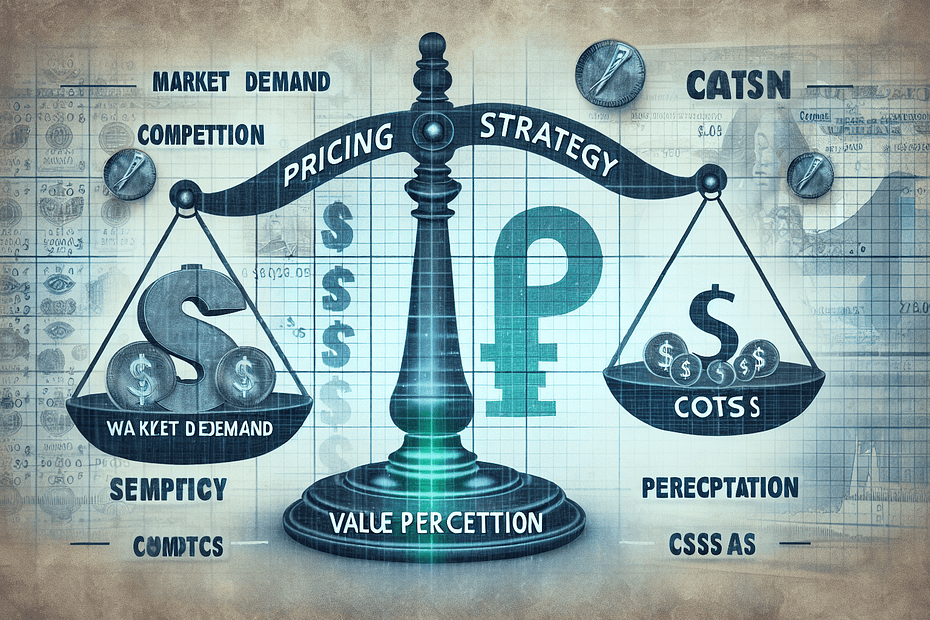Deciding on the perfect pricing strategy for your products or services can be a daunting task. After all, you want to ensure that you’re setting a price that is not only fair but also profitable for your business. However, with the right approach and a thorough understanding of your target market, you can confidently determine a pricing strategy that maximizes your revenue while keeping your customers satisfied. In this article, we will explore some key factors to consider when deciding on the right pricing strategy for your products or services. By the end, you will have a clear roadmap to follow, enabling you to set prices that strike the perfect balance between value and profitability.
Understand Your Costs
To determine the right pricing strategy for your products or services, it is crucial to first have a clear understanding of your costs. This involves identifying both your fixed costs and your variable costs.
Identify your fixed costs
Fixed costs are expenses that do not change regardless of the quantity of products or services you produce or sell. Examples of fixed costs include rent, salaries, utilities, and insurance. By identifying these costs, you can have a clear picture of how much revenue you need to generate to cover these expenses.
Determine your variable costs
On the other hand, variable costs are expenses that fluctuate based on the quantity of products or services produced or sold. These costs include materials, direct labor, and commissions. Determining your variable costs is important as it helps you understand how your pricing strategy should account for these expenses.
Calculate your breakeven point
Once you have identified your fixed and variable costs, you can calculate your breakeven point. The breakeven point is the point at which your total revenue equals your total costs, resulting in neither profit nor loss. By understanding your breakeven point, you can set your pricing strategy to ensure that you generate enough revenue to cover your costs and make a profit.
Analyze Market Conditions
Understanding market conditions is essential when determining the right pricing strategy. This involves researching your target market, studying competitors’ pricing strategies, and considering supply and demand factors.
Research your target market
To effectively price your products or services, you need to have a deep understanding of your target market. Conduct market research to gather insights on customer preferences, purchasing behavior, and price sensitivity. By understanding your target market, you can align your pricing strategy to meet their needs and expectations.
Study competitors’ pricing strategies
Analyzing your competitors’ pricing strategies can provide valuable insights into the market dynamics. By studying their pricing models, you can determine whether you want to position your pricing strategy as competitive, premium, or value-oriented. This analysis will help you identify gaps or opportunities in the market that you can leverage for your own pricing strategy.
Consider supply and demand factors
Supply and demand play a significant role in pricing strategy. If the demand for your products or services is high and the supply is limited, you may be able to set higher prices and maintain profitability. Conversely, if the market is saturated or demand is low, you may need to adjust your pricing strategy to remain competitive. By considering supply and demand factors, you can ensure that your pricing aligns with market conditions.
Define Value Proposition
Defining your value proposition is essential in determining the right pricing strategy. Your value proposition is what sets your product or service apart from competitors and provides value to customers.
Identify the unique selling points of your product or service
What makes your product or service unique? Identify the features, qualities, or benefits that differentiate it from competitors. Whether it’s superior quality, innovative features, or exceptional customer service, understanding your unique selling points will help you determine the value that customers perceive in your offering.
Determine the benefits it offers to customers
Understanding the benefits your product or service offers to customers is crucial in setting the right price. Consider how your offering solves a problem or fulfills a need for customers. Highlighting these benefits will help customers see the value they will receive in exchange for the price they pay.
Assess the perceived value by customers
Perceived value refers to how customers evaluate the benefits they receive compared to the price they pay. Assessing the perceived value by customers will help you understand how much they are willing to pay for your product or service. Conduct surveys, gather feedback, and analyze customer reviews to gauge their perception of your offering’s value.
Segment Your Customer Base
Not all customers are the same, which is why segmenting your customer base is essential in determining the right pricing strategy. By identifying different customer segments, you can customize pricing strategies to cater to their specific needs and preferences.
Identify different customer segments
Evaluate your customer base and identify different segments based on demographics, buying behavior, or other relevant factors. For example, you may have segments such as price-sensitive customers, premium customers, or customers who prioritize convenience. Understanding these segments will allow you to tailor your pricing to their specific needs.
Analyze their willingness to pay
Each customer segment may have different levels of willingness to pay for your product or service. Analyze market research data, conduct surveys, or track customer behavior to evaluate how much each segment is willing to pay. This information will help you determine the pricing strategies for each segment.
Customize pricing strategies for each segment
Once you have identified different customer segments and analyzed their willingness to pay, it’s time to customize pricing strategies for each segment. For price-sensitive customers, you may consider offering discounts or promotions. For premium customers, you can offer added value or higher-priced packages. By tailoring your pricing strategies to each segment, you can maximize revenue and cater to diverse customer needs.
Consider Pricing Objectives
When determining the right pricing strategy, it is essential to consider your pricing objectives. These objectives can vary depending on your business goals and market conditions.
Maximize profits
If your primary goal is to maximize profits, you may set prices higher to achieve higher margins. However, it is crucial to consider customer demand and price sensitivity to ensure that the higher prices do not negatively impact sales volume.
Increase market share
In competitive markets, gaining market share may be a priority. In such cases, you may consider setting lower prices to attract customers and gain a larger market share. This strategy aims to stimulate demand and create loyalty among customers.
Penetrate new markets
When entering new markets or introducing new products or services, you may consider using penetration pricing. This involves setting an initially low price to attract customers and gain a stronghold in the market. Over time, you can gradually increase prices as you establish your brand and customer base.
Maintain competitive pricing
Maintaining competitive pricing is essential in markets where price is a significant factor for customers. To remain competitive, you may need to adjust your pricing strategy based on market conditions and competitor pricing. Regularly monitoring the market and making necessary adjustments will help you stay competitive.
Evaluate Pricing Models
There are various pricing models that businesses can consider when determining the right pricing strategy. It is important to evaluate these models to determine which one aligns best with your business goals and market conditions.
Cost-plus pricing
Cost-plus pricing involves calculating the total cost of producing a product or delivering a service and adding a desired profit margin. This pricing model ensures that all costs are covered and a profit is made. However, it may not take market demand or competition into account.
Competitive-based pricing
Competitive-based pricing involves setting prices based on competitors’ prices. This strategy aims to match or undercut competitor prices to attract customers. While this approach can be effective in gaining market share, it may lead to lower profit margins if not carefully managed.
Value-based pricing
Value-based pricing involves setting prices based on the perceived value of your offering to customers. This strategy focuses on capturing the value that customers derive from your product or service. By aligning pricing with customer perceived value, you can potentially achieve higher profit margins.
Dynamic pricing
Dynamic pricing involves adjusting prices based on factors such as demand, time of day, or customer segments. This pricing model allows businesses to optimize revenue by setting prices that reflect market conditions and customer behavior. Dynamic pricing is often used in industries such as travel, hospitality, and e-commerce.
Test Different Pricing Strategies
To determine the right pricing strategy, it is crucial to test different approaches and measure their impact on sales and revenue. Testing different pricing strategies allows you to gather data and insights to make informed decisions.
Run A/B tests to gauge customers’ response
A/B testing involves comparing two versions of a pricing strategy to determine which one performs better. For example, you can test different price points, discounts, or packaging options to see how customers respond. Gathering data from these tests will provide insights on customer preferences and help optimize your pricing strategy.
Analyze the impact on sales and revenue
As you implement different pricing strategies, closely monitor their impact on sales and revenue. Keep track of key metrics such as units sold, profit margins, and customer retention. By analyzing these data, you can identify which pricing strategies drive the most favorable results and adjust accordingly.
Experiment with discounts or promotions
Discounts or promotions can be effective in influencing customer behavior and driving sales. Experiment with different types of discounts (percentage-based, BOGO, etc.) or promotional offers to see how they impact customer response and revenue. By testing various discount strategies, you can determine which ones resonate most with your target customers.
Consider Psychological Pricing
Psychological pricing techniques can influence customers’ perception of value and increase sales. Consider incorporating these strategies into your pricing efforts to optimize customer response.
Use charm pricing (e.g., $9.99 instead of $10)
Charm pricing is based on the theory that customers perceive prices ending in .99 or .95 as significantly lower than rounded numbers. For example, pricing a product at $9.99 instead of $10 tends to create the perception of a bargain. Experiment with charm pricing to see if it positively impacts customer behavior and sales.
Employ prestige pricing (premium pricing for perceived luxury)
If your product or service is positioned as a luxury or high-end offering, you may want to consider prestige pricing. Premium pricing creates the perception of exclusivity and high quality. This strategy often relies on aligning higher prices with the desired brand image and target market expectations.
Offer bundle pricing (discounts for purchasing multiple items)
Bundle pricing involves offering discounts or incentives for customers who purchase multiple items together. This strategy encourages customers to spend more and can increase overall revenue. Experiment with bundle pricing options to see how customers respond and whether it positively impacts your bottom line.
Review and Adjust Pricing
Pricing strategy is not a one-time decision; it requires continuous evaluation and adjustment. Regularly reviewing and adjusting your pricing strategy will help you stay competitive and maximize profitability.
Monitor sales performance
Keep a close eye on your sales performance and track key metrics such as units sold, revenue, and profit margins. Identify any trends or patterns in your sales data that may indicate the need for pricing adjustments.
Gather customer feedback
Customer feedback is invaluable when it comes to pricing. Conduct surveys, gather reviews, or engage in direct conversations with your customers to understand their perception of your pricing. This feedback can provide insights into potential areas for improvement or opportunities for pricing optimization.
Stay updated with market trends
The market is constantly evolving, and pricing strategies need to adapt accordingly. Stay updated with market trends, industry news, and changes in customer behavior that may impact your pricing decisions. By staying informed, you can proactively adjust your pricing strategy to remain competitive.
Make necessary pricing adjustments
Based on the data, feedback, and market trends you gather, make necessary pricing adjustments. This may involve tweaking price points, introducing new pricing models, or exploring new pricing strategies. Continuously evaluate the impact of these adjustments and be willing to adapt as needed.
Seek Professional Advice
If you feel overwhelmed or unsure about determining the right pricing strategy, don’t hesitate to seek professional advice. Consulting marketing experts or pricing consultants can provide valuable insights and guidance tailored to your specific business needs.
Consult marketing experts or pricing consultants
Marketing experts or pricing consultants have specialized knowledge and experience in developing effective pricing strategies. Their expertise can help you navigate the complexities of pricing and provide recommendations based on industry best practices.
Hire a pricing strategist
For businesses with more complex pricing requirements or industries with unique pricing challenges, hiring a dedicated pricing strategist may be beneficial. Pricing strategists can analyze market dynamics, conduct in-depth pricing research, and develop comprehensive pricing strategies tailored to your business.
Attend workshops or conferences on pricing strategies
Attending workshops or conferences dedicated to pricing strategies can be a valuable learning experience. These events provide opportunities to network with industry professionals, learn from experts, and gain insights into emerging trends and best practices. Consider participating in such events to expand your knowledge and stay ahead in pricing strategy.
In conclusion, determining the right pricing strategy for your products or services requires a comprehensive understanding of your costs, market conditions, value proposition, customer segments, and pricing objectives. It also involves evaluating various pricing models, testing different strategies, considering psychological pricing techniques, and regularly reviewing and adjusting your pricing decisions. Seeking professional advice can further enhance your pricing strategy and ensure that you make informed decisions to maximize profitability and drive business growth.





